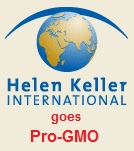 By Marcia Ishii-Eiteman
By Marcia Ishii-Eiteman
Ground Truth
Farmers, Indigenous people and rural communities around the world celebrated the International Day for Biological Diversity last week. But casting a long shadow was the news that big funders and new NGOs are teaming upwith the pesticide-biotech giant, Syngenta, in a renewed effort to push genetically engineered rice forward in Bangladesh and the Philippines.
Nicknamed “golden rice,” this untested, highly controversial GE crop threatens biodiversity across the region and risks bringing economic and ecological disaster to Asia’s farms.
The Bill and Melinda Gates Foundation has approved $20 million in new monies towards the development of “golden rice.” Meanwhile, Helen Keller International (HKI), a New York-based health and nutrition NGO, has also jumped on board.
Speaking from Malaysia, Sarojeni V. Rengam, Executive Director of Pesticide Action Network Asia and the Pacific (PAN AP) called on the donors and scientists involved to wake up and do the right thing:
Golden Rice is really a ‘Trojan horse’; a public relations stunt pulled by the agri-business corporations to garner acceptance of GE crops and food. The whole idea of GE seeds is to make money.
On this International Day for Biological Diversity, we want to send out a strong message to all those supporting the promotion of Golden Rice, especially donor organizations, that their money and efforts would be better spent on restoring natural and agricultural biodiversity rather than destroying it by promoting monoculture plantations and genetically engineered (GE) food crops.
In agreement, hundreds of farmers, scientists, consumers and workers protested in the Philippines. But instead of listening to the thousands of Asian family farmers saying “NO to GMOs,” the International Rice Research Institute (IRRI), which is receiving $10.3 million of the Gates funds, created a promotional video highlighting their delight in having found new partners like HKI.
An economic and ecological disaster
Introducing this GE crop into Asia — the center of diversity for rice — is ecologically, socially and culturally irresponsible. Here’s why:
Threats to cultural and biological diversity
As a result of the first “Green Revolution,” thousands of traditional and indigenous varieties of rice have been lost across Asia — and with them, cultural knowledge of their management, replaced with a handful of hybrid varieties requiring heavy doses of chemical pesticides and fertilizers. As Slow Food argues, “golden rice” threatens to speed up that process, with the added risk of genetic contamination of Asia’s most precious resource.
Corporate profit over food sovereignty
Golden rice is a Trojan horse for pushing through GE-friendly biosafety regulations under the guise of humanitarian aid. Once in place, these regulations open the door for the biotech industry to bring in commercial, patented GE crops; USAID and Monsanto accomplished exactly this in Kenya with their sweet potato project. This raises serious equity concerns for both farmers and national governments as they become beholden to biotech giants and lose their rights to save and exchange seed.
Economic losses
Once GE rice contaminates a country’s rice supply and enters the food chain — which it will — these countries will lose crucial agricultural export markets to Japan and Europe.
Loss of livelihood
Long-term field studies for robustness to climate change and other stressors haven’t been conducted for golden rice, putting the livelihoods of small-scale farmers at risk.
And anyway, it won’t work
Vitamin A uptake depends on the presence of fats or oils in a person’s diet. There’s no point in pushing “golden rice” when people can’t access or afford the diet they really need to make use of it. Especially when it comes packaged in a monocultural production system that undermines the very dietary diversity that they need. Smarter, cheaper alternatives exist. Most important is recognizing that poverty is the underlying reason for nutritional deficiencies. This can’t be solved with a technological fix.
Whose hands in the pot?
Who oversees this ambitious project, which its advocates claim will end the suffering of millions? An elite, so-called “Humanitarian Board” where Syngenta sits — along with the inventors of Golden Rice, Rockefeller Foundation, USAID and public relations and marketing experts, among a handful of others.
Not a single farmer, indigenous person or even an ecologist, or sociologist to assess the huge political, social, and ecological implications of this massive experiment. And the leader of IRRI’s Golden Rice project is none other than Gerald Barry, previously Director of Research at Monsanto.
Unfortunately, well-meaning NGOs are getting caught up in the GE web. Helen Keller International has done some really top-notch work to enrich the diets of thousands of families in Asia with micronutrients, including Vitamin A. This is exactly the right sort of thing to be investing resources in.
But earlier this year, HKI decided to jump on the GE bandwagon, agreeing to conduct efficacy studies for IRRI. Even if the engineered rice can be proven “efficacious” in the narrow sense that is meant — able to deliver Vitamin A in a biologically available form — the project still threatens the biological and cultural diversity of an entire region and clearly contradicts the desires of the local people.
HKI, do the right thing and get out. You have too much in the way of good ideas and initiatives to throw your reputation away by doing Monsanto and Syngenta’s dirty work. It’s not too late to extract yourself from this giant genetic misadventure.






“Biological Diversity”…what a misused term! So, who’s powerful enough to stop these criminals? Hands up!
lol
<— hand raised
Hand raised here too!
I read about the IRRI sometime ago and I was not too sure of their allegiance regarding the small farmers. Seems they were playing wolf in sheep’s clothing.
As for standing up against these devious villains its easy. Simply stick together and keep hammering away at their greenwash, propaganda and doublespeak. We will win in the end by solidarity of effort. If we walk away thinking its too difficult then we deserve everything we get.
The tide is turning in the US and I as an outsider have watched the change occurring over the last 2 years. Its becoming a tsunami of dissent with regards the type of food people want to eat. Its starting to become embarrassing for senators to stick with their corporate buddies. It may only be a few now but 2 years ago I was finding it hard to communicate with anyone outside of scientific circles who even knew anything about GMO’s and the harm they cause. Now there are tens of thousands of people everyday signing petitions and writing letters protesting about the need for GMO food ingredients to be listed on the label. Its only one of the many issues that have changed. If we can keep the momentum going and spread the word to those in Asia based on our own previous experiences then we can stop this mess from spreading. Its never too late to stop the rot.
Kev_C said: “Now there are tens of thousands of people everyday signing petitions”
And now there are tens of thousands of people everyday signing petitions, who still don’t know anything about GMOs.
Well said Kev_C!
In case I haven’t mentioned it here; I don’t buy anything that contains corn, soy, canola or cottonseed, as well as MSG, artificial sweeteners, colours, flavours and a whole bunch of other toxins.
The recent complete cave-in on the issue of GMO Alfalfa regulation – basically giving Monsanto and Forge complete freedom in the marketplace, is a serious blow to natural foods and American freedom to choose organic foods over so-called “frankenfoods.” Vilsack’s previous close ties to Monsanto may well be the reason of this regrettable decision to release GMO Alfalfa without regulation anywhere inside the USA.
time to send all GM food and crops off planet
Pingback: Genetically Engineered Rice Threatens Asian Countries « To Your Health
Pingback: Genetically Engineered Rice Pushed by Bill Gates & Monsanto | Natural Society
Pingback: Genetically Engineered Rice is a Trojan Horse: Misled by Bill Gates and Monsanto
I am surpassed that the Gates Foundation is starting to dabble in Golden Rice. The project is actual just trying to prove that they can “make” rice with increased vitamin A. All the Gates funding spent on these projects would go lot further if donated to grass roots organisations like Abalimi Ebhekaya that teach balanced diets and home vegetable gardening. A single carrot will produce more vitamin A than 5kg of golden rice…so what is the point of pressing some “monowonderfood”. An egg a day for a growing child will provide protein and vitamin A using a free range chicken, sratching in the cow manure and fed a small handful of sorghum a day. I have yet to see the rural African household that does not have a couple of free range chickens running around.
Pingback: Genetically Engineered Rice is a Trojan Horse: Misled by Bill Gates and Monsanto | Body Charge Nutrition
Pingback: Genetisch gemodificeerde rijst is een paard van Troje: misleid door Bill Gates en Monsanto | Am@zing Nieuws Blog
Pingback: Genetically Engineered Rice is a Trojan Horse « Karinconway's Blog
Pingback: News about golden rice. But why is news one-sided? #GMO | Master of My Universe
Pingback: Consciousness TV | Genetically Engineered Rice Misled by Bill Gates and Monsanto
Pingback: Bill Gates: One of the World’s Most Destructive Do-Gooders? | Freedom Report
Pingback: Bill Gates: One of the World’s Most Destructive Do-Gooders? | Dr Mercola
Pingback: Bill Gates: One of the World’s Most Destructive Do-Gooders? | We Want To Be Free
Pingback: One of the World’s Most Destructive Do-Gooders? » CFA Blog
Pingback: Bill Gates: One of the World’s Most Destructive Do-Gooders? » JFiNTeL.com
Pingback: Bill Gates: One of the World’s Most Destructive Do-Gooders? « Investment Watch Blog – 2012
Pingback: Bill Gates: One of the World’s Most Destructive Do-Gooders? – WNYTruthers.org
Pingback: Bill Gates: One of the World’s Most Destructive Do-Gooders? | | TaJnB | TheAverageJoeNewsBloggTaJnB | TheAverageJoeNewsBlogg
Pingback: Bill Gates: One of the World’s Most Destructive Do-Gooders? «
Pingback: Bill Gates: One of the World’s Most Destructive Do-Gooders? | Set You Free News
Pingback: Bill Gates: One of the World’s Most Destructive Do-Gooders? « Bill Totten's Weblog
Pingback: Bill Gates: One of the World’s Most Destructive Do-Gooders? | | WangoWebWangoWeb
Pingback: Genetically Engineered Rice Misled by Bill Gates and Monsanto
Pingback: Genetically Engineered Rice Misled by Bill Gates and Monsanto | Consciousness TV
Pingback: Bill Gates: One of the World’s Most Destructive Do-Gooders?
Pingback: Regaining Trust: Can a Corporation with a Bad History do Good? | Pro-Poor Social Innovation Index
Pingback: Bill Gates: One of the World’s Most Destructive Do-Gooders? | The Liberty Beacon
Pingback: Dangerous Liaisons: ChemChina’s Bid for Syngenta | We Seek the Truth!